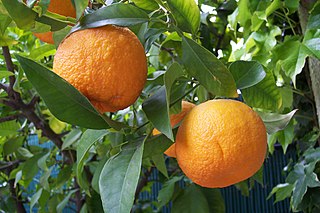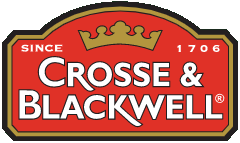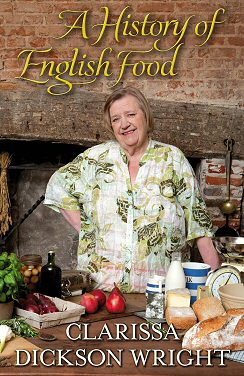
Marmalade is a fruit preserve made from the juice and peel of citrus fruits boiled with sugar and water. The well-known version is made from bitter orange. It is also made from lemons, limes, grapefruits, mandarins, sweet oranges, bergamots, and other citrus fruits, or a combination. Citrus is the most typical choice of fruit for marmalade, though historically the term has often been used for non-citrus preserves.

The quince is the sole member of the genus Cydonia in the Malinae subtribe of the Rosaceae family. It is a deciduous tree that bears hard, aromatic bright golden-yellow pome fruit, similar in appearance to a pear. Ripe quince fruits are hard, tart, and astringent. They are eaten raw or processed into marmalade, jam, paste or alcoholic beverages.

Bitter orange, sour orange, Seville orange, bigarade orange, or marmalade orange is in a narrow sense the citrus tree Citrus × aurantium and its fruit. It is native to Southeast Asia and has been spread by humans to many parts of the world. It is probably a cross between the pomelo, Citrus maxima, and the mandarin orange, Citrus reticulata.

Crosse & Blackwell is a British food brand. The original company was established in London in 1706, then was acquired by Edmund Crosse and Thomas Blackwell in 1830. It became independent until it was acquired by Swiss conglomerate Nestlé in 1960.

Alexander Keiller was a Scottish archaeologist, pioneering aerial photographer, businessman and philanthropist. He worked on an extensive prehistoric site at Avebury in Wiltshire, England, and helped ensure its preservation.

A baked apple is a dish consisting of an apple baked in an oven until it has become soft. The core is usually removed and the resulting cavity stuffed with sweet or savory fillings and seasonings. Pears and quinces may be prepared in the same way.
Robertson's is a British brand of marmalades and fruit preserves that was founded by James Robertson in 1864. The firm was run as a partnership until 1903, when it was incorporated as a limited company – James Robertson & Sons, Preserve Manufacturers, Limited. It produces the "Golden Shred" marmalade, a recipe created in 1874 and registered as a trademark in 1886, among other products including "Silver Shred" a lemon marmalade launched in 1909; "Mincemeat", a traditional Scottish style mincemeat made from raisins, peel, sugar and beef suet; and "Bramble Jelly", a traditional Scottish style jam, strained of its seeds. Robertson's received their first Royal Warrant from King George V in 1933.
Dundee is the fourth-largest city in Scotland with a population of around 150,000 people. It is situated on the north bank of the Firth of Tay on the east coast of the Central Lowlands of Scotland. The Dundee area has been settled since the Mesolithic with evidence of Pictish habitation beginning in the Iron Age. During the Medieval Era the city became a prominent trading port and was the site of many battles. Throughout the Industrial Revolution, the local jute industry caused the city to grow rapidly. In this period, Dundee also gained prominence due to its marmalade industry and its journalism, giving Dundee its epithet as the city of "jute, jam and journalism".

Fruit preserves are preparations of fruits whose main preserving agent is sugar and sometimes acid, often stored in glass jars and used as a condiment or spread.

Succade is the candied peel of any of the citrus species, especially from the citron or Citrus medica which is distinct with its extra-thick peel; in addition, the taste of the inner rind of the citron is less bitter than those of the other citrus. However, the term is also occasionally applied to the peel, root, or even entire fruit or vegetable like parsley, fennel and cucurbita which have a bitter taste and are boiled with sugar to get a special "sweet and sour" outcome.

Quince cheese is a sweet, thick jelly made of the pulp of the quince fruit. It is a common confection in several countries.

Dundee cake is a traditional Scottish fruit cake.

The Howff is a burial ground in the city of Dundee, Scotland. Established in 1564, it has one of the most important collections of tombstones in Scotland, and is protected as a category A listed building.
Events from the year 1889 in Scotland.

A History of English Food is a 2011 non-fiction book, a history of English cuisine arranged by period from the Middle Ages to the end of the twentieth century, written by the celebrity cook Clarissa Dickson Wright and published in London by Random House. Each period is treated in turn with a chapter. The text combines history, recipes, and anecdotes, and is illustrated with 32 pages of colour plates.

A Collection of Above Three Hundred Receipts in Cookery, Physick and Surgery is an English cookery book by Mary Kettilby and others, first published in 1714 by Richard Wilkin.
Shirriff is the brand name of several food products first produced by the defunct Shirriff family food products company in Toronto, Ontario, Canada.
Gabrielle Muriel Keiller was a Scottish golfer, art collector, archaeological photographer and heir to Keiller's marmalade in Dundee. She bequested a large collection of Dada and Surrealist art to the Scottish National Gallery of Modern Art.

The Western Cemetery in Dundee, Scotland, is a still-operational cemetery founded in the mid 19th century. It rises northwards from the Perth Road, with terraces in its upper sections. It views over the Firth of Tay to the Tay Rail Bridge and Fife. The Western Cemetery is maintained and managed by Dundee City Council.

Confections of the English Renaissance span a wide range of products. All were heavily based on sugar, which was a relatively new development. Many were considered to have medicinal properties – a belief that was influenced by the Arabic use of sugar as a medicine and that carried over from medieval sugar usage. In the mid-sixteenth century, sugar became cheaper and more widely available to the general populace due to European colonization of the New World. It began to be used more as a flavouring, preservative, and sweetener, as it is today, rather than as medicine.


















